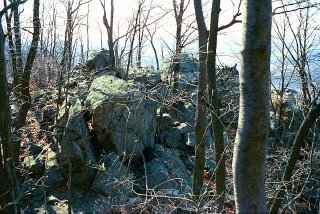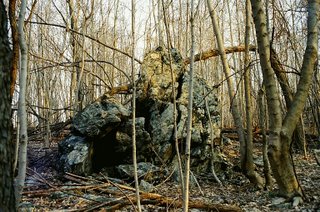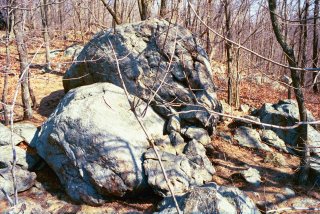Of Wasps and Snakes
I do have more material about the relationships between cultures and rocks, but I interrupt this meditation because I found some old photos that aren't good enough to post on the real rock blog, but which should be shared. I took these pictures during my one indiscretion of visiting a privately-owned site without permission, some years ago. This site had been important to my change from skeptic to believer in the concept that there were indeed unexplained stonework sites out there, and I was having difficulty getting anyone with permission to take me back, so I went there with a friend who was curious.
This one indiscretion resulted in my being stung 70 times by yellow jackets and being caught by the irate property owner (after the stings) and being told off in no uncertain terms by the person who first showed me the site. I have never done something like that again.
Along with all that, the pictures turned out kind of peculiar and hardly captured the vision that first arrested me. Nevertheless, here are some of them, photos of a rock ridge running up the side of a hill by the Lehigh River.
It's an odd ridge of rock, narrow and high running straight up a hill that has no similar features.
 The rocks that make it up are peculiar and bumpy in some areas, like no other rocks I've seen in our area.
The rocks that make it up are peculiar and bumpy in some areas, like no other rocks I've seen in our area.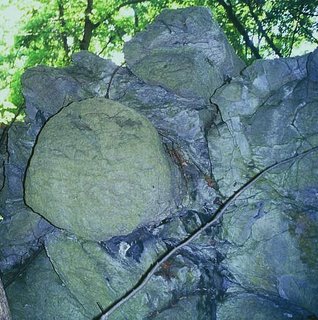
Nearby on the ground, I found this very unusual carved-looking stone. Or maybe it was something else? Cement that looked like stone? I've never seen anything like it.
 Here's a view along the top of the rock ridge looking down the hill toward the road and the stream that runs along it.
Here's a view along the top of the rock ridge looking down the hill toward the road and the stream that runs along it.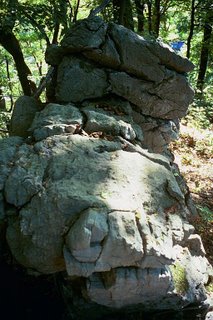
More of the rock ridge with a gap before the top part . . .
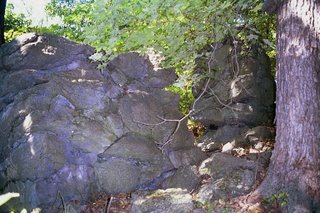 And here's the kicker--at the top end of the rock ridge is the stone below. It is taller than I am (the whole ridge is, all the way up) and it looks startlingly like a reptile head, (turtle? maybe snake because of the long ridge behind it) complete with eye and with the mouth open as if for offerings. The peculiar colors in some of these photos must be a result of the light and shadow in that place on that day. I have more of these odd purplish-blue rock pictures from there, including another of this stone head. It was while walking back down the hill from here that I stepped in the yellow jacket nest, an experience I will always remember.
And here's the kicker--at the top end of the rock ridge is the stone below. It is taller than I am (the whole ridge is, all the way up) and it looks startlingly like a reptile head, (turtle? maybe snake because of the long ridge behind it) complete with eye and with the mouth open as if for offerings. The peculiar colors in some of these photos must be a result of the light and shadow in that place on that day. I have more of these odd purplish-blue rock pictures from there, including another of this stone head. It was while walking back down the hill from here that I stepped in the yellow jacket nest, an experience I will always remember.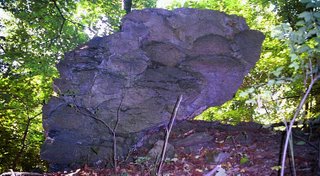
Another odd thing from that day was this picture. It's just a trick of leaves and light, and I didn't see it as anything but a rock when I took it, but the impression of a face is hard to ignore.

In short, although I am reluctant to attribute to the sites any supernatural qualities of an eerie type, this was one of the days about which I will always have doubts. I guess we all have those, and maybe we all need them.
The circumstances of my first visit there were also memorable, but humorous, and then almost giddy as the site of this rock formation cracked open my head, allowing a new understanding to enter.
